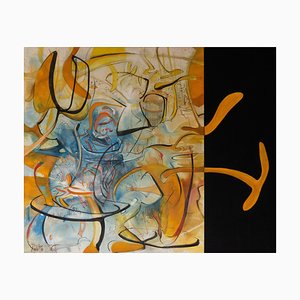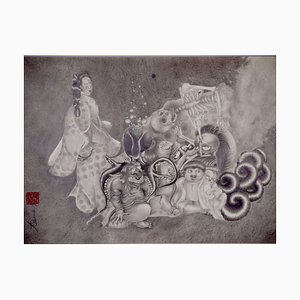Acrylic, gouache, Japanese mineral pigment, gold leaf on panelled linen Hiromi Sengoku is a Japanese artist born in 1982 who lives and works in London, UK. Since 2008, she participated regularly to solo exhibitions in Japan and participated in numerous group exhibitions. She also joined art fairs both domestically and internationally with NICHE gallery and galerie bruno in Paris & Tbilisi. Notable awards include the Holbein Scholarship (2004), the Shell Art Award - Kunio Motoe Jury Prize (2011), Ueno Royal Museum Grand Prize Exhibition Nominee (2015), and the Sompo Japan Nipponkoa Museum of Art FACE Award/ Grand Prix (2018). She also participated as a jury member for the Holbein Scholarship in 2019 & 2021. In addition to my ongoing theme of 'reconstructing classical oil painting techniques and styles with a contemporary perspective,' Hiromi has been using a variety of painting materials in recent years, including acrylics, tempera, and mineral pigments, especially aqueous ones. This exploration stems from a desire to reconsider painting in a society that is becoming increasingly diverse and globalized while reconnecting with my identity as an artist rooted in the East of Japan. Throughout history, painting materials and techniques have developed in close relation to the climate, culture, and society of their respective regions. Artistic traditions from around the world have diversified and, in modern times, actively incorporated influences from other cultures. For example, the transmission of perspective techniques from the West to Japan during the Edo period, as well as the influence of non-Western painting traditions on Western artists from the era of Japonism to modern and contemporary artists like Matisse and Hockney for example, demonstrate the significant impact of cross-cultural exchange on painting. However, when revisiting the history of painting, she noticed that before the differentiation of painting materials and techniques, there were many commonalities. Pre-Renaissance works such as tempera and frescoes shared simplicity in lines and flat color surfaces, and an expression of space that did not rely on perspective. These aspects had significant parallels with Japanese Yamato-e paintings, and there were similarities in the use of isometric perspectives with oblique lines and the depiction of human figures and creatures. This shared expression had a deep connection with the inherent properties of the painting materials. The artist found the source of these common expressions in ancient cave paintings. Using pigments made from readily available materials, ancient artists created images on cave walls, utilizing the texture of the rock surface to bring their depictions to life with minimal lines, even conveying spatial depth. The desire of humans to 'recreate images on a flat surface' is primal, and the excitement when lines and colors begin to form images, giving birth to 'the world,' is a universal experience transcending time and culture. This primal sensation of 'the world emerging on a flat surface' is what I aim to capture on canvas, allowing viewers to rediscover and experience the 'illusion' inherent in paintings. To achieve this, she deliberately retains elements such as visible drawing lines and the materiality of natural paints in my works. The unpredictable qualities of water-based paints, like their absorption and uncontrollable spreading, not only aid in this endeavor but also infuse the works with an Eastern sensibility. The subjects of her paintings are drawn from everyday life, often highlighting seemingly inconspicuous moments or words that resonate with me. This process is driven by my desire to depict the universality of our world and, at its core, the hope to find something meaningful even in the textures and stains on the canvas. The use of tempera has been a key discovery for me, as it allows for the seamless combination of water-based and oil-based painting materials, enabling the incorporation of both Eastern and Western aspects of painting into my works. As an artist with roots in Japan who has also learned and lived in both Japan and Western Europe, Hiromi Sengoku explores how to remix Eastern and Western influences within my own work. In today's increasingly globalized society, rigidly adhering to one side feels unnatural. She makes the coexistence of Eastern and Western elements resonate with the issues of lines and color surfaces in painting, and continuously seek ways to achieve this balance in her work.
























Get in Touch
Make An Offer
We noticed you are new to Pamono!
Please accept the Terms & Conditions and Privacy Policy
Get in Touch
Make An Offer
Almost There!
To follow your conversation on the platform, please complete the registration. To proceed with your offer on the platform, please complete the registration.Successful
Thanks for your inquiry, someone from our team will be in touch shortly
If you are a Design Professional, please apply here to get the benefits of the Pamono Trade Program